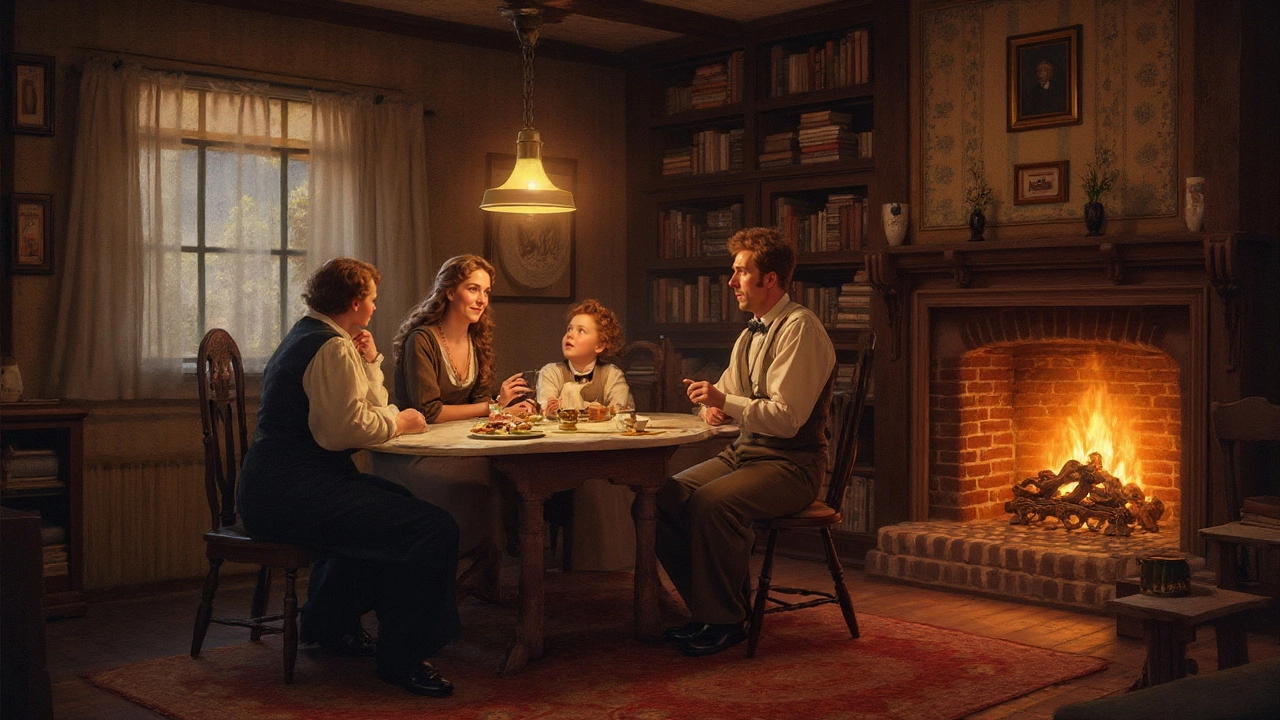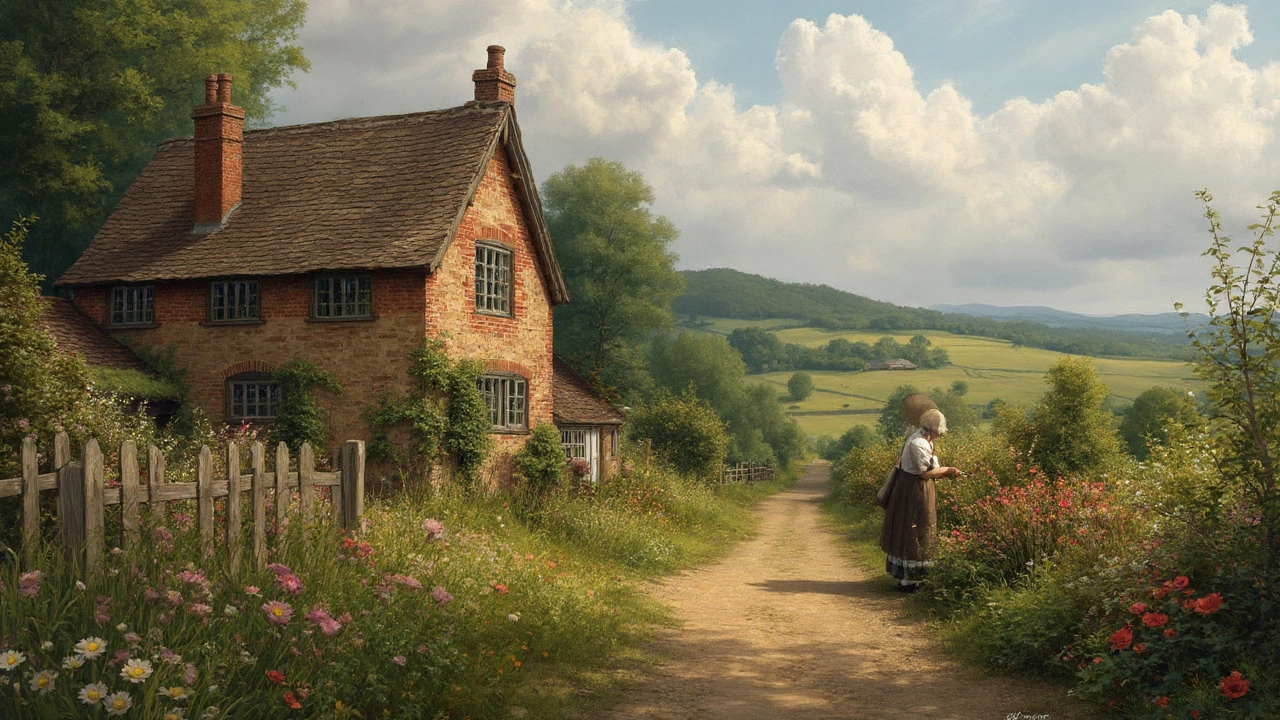Ever sat by a fireplace in a cozy cottage and stopped to think: why do we even call it a "cottage"? The word just rolls off the tongue, packing a punch of nostalgia, comfort, and maybe a whiff of fresh-baked bread. But it’s one of those words you rarely pause to question. It’s such a familiar part of countryside life—yet the name has a deep, tangled history and some fun twists you probably haven’t heard.
Where Does the Word Cottage Come From?
If you look at a dictionary now, "cottage" usually means a small house, often in the countryside, charming as heck and maybe with a thatched roof. But that definition barely scratches the surface. The story of the word moves across countries, languages, and social classes.
The roots go back to the Middle Ages in England. The word "cottage" pops out of Old French “cote” (meaning hut) and from the Medieval Latin “cotagium.” Back in those centuries, to be a "cotter" meant you were a farm laborer renting a small dwelling. These tiny houses weren’t possessions—they were work perks! If you toiled for a lord or on someone else’s land, you typically got a modest stone or wood shelter thrown in as part of your deal. There was a catch, though. You usually had to give up a share of your harvest, your labor, or both.
Even the Domesday Book of 1086—England’s famously obsessive medieval record—mentions “cotters” specifically. If you lived in a cottage, you were usually near the bottom of the rural food chain, with your home defining your spot in society as much as your job title did. That “cotter” idea stuck around for centuries, across England and Scotland. As you might guess, cottages started out as pretty rough and ready, with mud floors, thatch or turf roofs, and walls you could punch a hole in. The whole thing was practical, functional, made for surviving more than thriving. But, even then, each cottage was an anchor for families, tradition, and community. That’s where the magic began.
Why Are They Still Called Cottages?
So, the "cottage" started as the name for a pretty basic home, given to the folks who worked the land. Here’s where it gets interesting: the romance of the cottage lives on, despite those humble roots. Over hundreds of years, styles, building materials, and who got to live in a cottage changed, but the label stayed stubbornly put.
After the industrial revolution, as people swarmed into the cities, tiny rural homes suddenly became symbols of peace and simplicity. By the 1800s—thanks to poets like Wordsworth and painters who loved stone walls and sheep, with a dash of wildflowers thrown in—the "country cottage" had a brand new image. Now, instead of just basic worker’s digs, cottages became symbols of the "good old days," comfort, and escape from modern chaos.
People with money started to covet them. The lucky few built their own versions as weekend retreats kicked up several notches—think slate roofs, leaded-glass windows, and home-baked pies. This twist meant the word stuck, but the meaning changed based on who you asked and where you looked.
In today’s real estate listings, you’ll find everything from 17th-century stunners to suburban "cottages"—sometimes enormous places with spa bathrooms. But if you get down to brass tacks, the thing every cottage has in common is that feeling of cozy, personal space. It doesn’t matter if it’s two rooms or ten. The name remains.
| Century | Origin/Meaning | Key Facts |
|---|---|---|
| 11th | Cotter’s dwelling (Domesday Book) | Basic shelter for rural workers, often tied to agricultural labor |
| 15th | General use in England | Seen as small, practical homes for working families |
| 19th | Romanticized countryside retreat | Became symbols of peace, poets and artists popularized the image |
| 21st | Modern cozy dwellings | Real estate runs with everything from old to brand-new "cottages" |

The Many Faces of Cottages
Walk through an English village, an American lakeside, or a Scandinavian hamlet and shout "cottage!" and you’ll spot wildly different houses. The cottage comes in more styles than ice cream flavors, each with its own story. If you ever get to travel through Cornwall, you’ll see quaint stone cottages with painted doors and overflowing gardens—classic stuff. Head over to Canada? Their lakeside "cottages" could look borderline modern, more like mini-houses built for long weekends away from the city.
Irish cottages, famous for their thick whitewashed walls and roofs of straw, have their own bursts of charm. Some of the most photographed homes in the world are traditional Irish cottages, standing up bravely in wild, windy landscapes. Meanwhile, in the U.S., calling something a "cottage" might mean a tidy bungalow on Cape Cod or a tiny weekend hut tucked into woodland. Australians use the term too, but they might be talking about small holiday rentals on the beach.
Here’s a funny twist—"cottage" is one of those rare words that tells you more about hopes and atmosphere than about bricks or floor plans. If it feels close-knit, snug, and filled with warmth, it’ll get that name, no matter what the building looks like. So, it’s about the vibe as much as the size or age.
- In Sweden, a "stuga" is their take on cottages. Small and painted red, these are still the heartbeat of many summer family holidays.
- Scotland’s “blackhouses” are stone cottages built to withstand rough island weather. The walls are so thick they look bomb-proof.
- Germany offers “Fachwerkhaus,” or timbered cottages framing bright flowers in dusty window boxes.
It’s not just a house—it’s a place to retreat, sew on a lost button, and sip tea after a bad day. That’s why the idea of the cottage keeps spinning around the world, showing up in new disguises but always serving that core of comfort and togetherness.
What Makes a Home a Cottage Today?
Cottage isn’t just a fancy label or a real estate trick. The modern definition brings some mix of old soul and new comfort. But if you dig past the property hype and Pinterest images, what’s at the heart? There’s a cluster of traits that makes people call a house a cottage—and maybe even dream a bit about living in one.
First, it’s usually small. Don’t expect endless hallways or palatial staircases. Most cottages lean into practical living—just enough space to gather, cook, maybe sleep under the same roof as your slippers. There’s character, never blandness. You’ll see quirky window shapes, sagging beams, or that tucked-away pantry grandma would’ve loved. Gardens—sometimes wild, sometimes tended—play a big part. Some of the best stories spin out over low garden walls with neighbors, or from wild children’s games around an apple tree.
Location adds another layer. You’ll find cottages hugging cliff edges, next to rivers, or surrounded by rolling fields. Some are squeezed into city nooks, a surprise oasis sandwiched between brick and concrete. Even if it’s just one room, the cottage idea brings a pocket of calm.
- Tip: When searching for true cottages (not just "cottage style" houses), keep an eye out for buildings with visible age. Old stonework, timber beams, and low ceilings often hint at the real deal.
- Cottages tend to have a story. If you get the chance, chat to an older local—they’ll know which ones have the best legends attached.
- Look for names like “Rose Cottage,” “Ivy Cottage,” or something equally sweet and flowery.
Today, eco-friendly renovations are everywhere. Solar panels on that ancient roof? Not such a wild idea anymore. People want energy-efficient "country cottages" that don’t gulp electricity or lose heat. Cutting-edge insulation inside old stone walls is now a hot trend in places like the Cotswolds. The marriage of old structures with new tech keeps these homes alive and loved, rather than dusty antiques. Some buyers get creative: converting sheds, farm outbuildings, and even water towers into modern cottages full of character.
One last thing: when it comes to hosting friends or listing on booking apps, calling your place a cottage just works. It draws in everyone looking to unplug and unwind. Data from a 2024 U.K. travel survey showed that “cottage holidays” saw a 20% spike in bookings compared to standard hotels, especially among folks aged 30 to 45. Turns out, people want coziness and charm over cookie-cutter apartments.
So, the next time you spot a home that oozes that welcoming, snug vibe, you’ll know exactly why it’s called a ‘cottage’—and the story goes way deeper than just four walls and a chimney.

